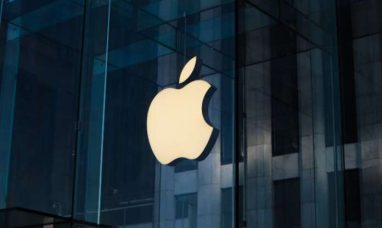Apple Stock (NASDAQ:AAPL)
Apple’s (NASDAQ:AAPL) unrivaled brand devotion and a vast network of products, programs, and services allowed it to forge an insurmountable competitive edge. For the past ten years, this has resulted in remarkable financial performance. Apple is one of the most lucrative corporations in the world thanks to its ability to charge premium prices while retaining high margins. Also, a discounted cash flow [DCF] study of Apple stock indicates that it is undervalued, demonstrating that the market has not yet fully recognized the company’s potential for growth.
Furthermore, my theory is further supported by a favorable consensus regarding long-term projections and predictions for the company’s revenue growth over the following ten years. The strength of Apple’s brand loyalty, financial performance, and growth possibilities surpass any potential hazards, even if investing in any firm carries some risk. As a result, long-term investors should think about including Apple in their portfolios.
About the Company
Steve Jobs, Steve Wozniak, and Ronald Wayne established Apple in Cupertino, California, in 1976. In 1976, the “Apple I,” the original Apple computer, went on sale for $666.66. The company’s line of cutting-edge items has completely changed how people live. Computers became more usable with the introduction of the Apple computer’s graphical user interface. With the iPod, consumers could carry their complete music library with them at all times. By combining phone, music player, and computer features into one device, the iPhone completely altered the smartphone market. The iPad, Apple Watch, and AirPods are just a few examples of items that show how Apple has influenced the technological sector.
As Senior Vice President for Global Operations, Tim Cook joined Apple in 1998. On August 24, 2011, he succeeded Steve Jobs as CEO of Apple. Jobs had resigned owing to health concerns.
Five reportable segments—iPhone, Mac, iPad, Wearables, Home and Accessories, and Services—are used by the corporation to break down its sales. The iPhone division, which accounted for nearly 56% of revenues in the most recent reporting quarter, is the company’s biggest source of income.
Considering a company’s financial success over time is essential when choosing an investment. Analyzing Apple’s financial performance over the last ten years can provide important details about the company’s growth trajectory, its capacity for profit, and how it has fared against adversity.
Apple Inc. has had an excellent financial performance during the last ten years, with sales increasing by a total of 130.7%, from $170.9 billion in FY2013 to $394.2 billion in FY2022. The iPhone, the company’s flagship product, and its growing services division have been the main drivers of this expansion. Also, there has been a huge increase in gross profit, which has grown from $64.3 billion in FY2013 to $170.8 billion in FY2022, representing a cumulative gain of 165.6%. Also, the company’s gross profit margin, which is currently 43.3%, has continuously been in the high 30s to low 40s. Apple’s ability to innovate has allowed it to produce these outstanding outcomes, which would not have been possible without huge R&D expenditures.
With an operating margin ranging from 24% to 31% over the previous ten years, Apple’s operating profit increased from $49 billion in FY2013 to $119.4 billion in FY2022. Apple has also produced excellent levered free cash flow (FCF), with a cumulative growth of 40.3% over the last ten years. Also, the company’s FCF margin has continuously maintained around 15%, demonstrating a strong capacity for cash flow from operations.
Apple has also given its stockholders a lot of value between FY 2013 and FY 2022 through dividends and share repurchases. The corporation distributed $129.4 billion in dividends over the previous ten years, with each payment rising steadily. Also, over the same time span, Apple spent $582.0 billion on share repurchases, with the largest sums taking place in FY2018 and FY2021. This emphasis on providing dividends and share buybacks to shareholders shows Apple’s dedication to enhancing shareholder value.
Overall, Apple’s financial results over the previous ten years show a business that continuously produced significant sales and profit growth and had a strong capacity to create cash from operations.
On February 2, 2023, Apple released its most recent quarterly earnings report. The company’s normalized EPS was $1.88, which was $0.07 below estimates. The GAAP EPS was $1.88 as well, falling short of expectations by the same amount. Apple’s sales for the quarter were $117.15 billion, although it was $4.5 billion less than expected.
Revenue decreased by around 5% from the prior year during the quarter, primarily because pandemic-related restrictions on its Chinese facilities reduced demand for the newest iPhone during the holiday shopping season. The production is now back where it should be, but Tim Cook informed investors during the earnings call that they manage for the long term by investing in innovation and people. More than 2 billion iPhones, iPads, Macs, and other gadgets are currently in use, according to Apple, which could increase sales of digital subscriptions and advertisements and support long-term revenue growth.
Apple’s management opted not to issue revenue guidance for the following quarters due to global unpredictability. Nonetheless, based on the supposition that the macro outlook and COVID-related consequences on their business stay unchanged from what they are currently anticipating for the current quarter, they gave some observations. They anticipate that the March quarter’s YoY revenue performance will be comparable to the December quarter’s performance, with foreign exchange remaining a challenge. Additionally, they anticipate that despite macroeconomic challenges in mobile gaming and digital advertising, services revenue would increase YoY. They anticipate an acceleration in iPhone’s YoY topline performance in the March quarter compared to the December quarter. However, due to difficult comparatives and macroeconomic headwinds, they anticipate a double-digit YoY revenue loss for Mac and iPad. Thus, they anticipate the gross margin to range from 43.5% to 44.5%.
Notwithstanding the fact that the company is having difficult quarters, I am certain that Apple will resume its development trajectory given the solid track record of success of the management team and the company’s distinctive positioning with innovations. This conviction for the following ten years is further supported by the optimistic consensus earnings predictions.
Value Suggests Undervaluation
When using conventional valuation ratios, some analysts and investors may contend that the company is currently significantly overvalued.
Although these ratios imply that Apple’s stock may be overpriced, it is crucial to remember that due to the company’s distinct market positioning and profitability, such ratios may not fully reflect the company’s true value. When valuing companies, I think we should use a holistic approach, taking into account elements other than the usual valuation criteria to establish the company’s fair worth.
As a result, since Apple is still a growth stock, I favor DCF analysis in this instance. In order to avoid overestimating future cash flows, I also use very conservative assumptions. For DCF modeling, it would be smart to use the most recent levered FCF margin multiplied by consensus revenue expectations. I base my analysis on historical FCF margin data since making assumptions that are at odds with the firm’s past performance can cause the output of the model to differ from the actual outcomes. A concession rate serves as the second important premise. I use WACC calculated by GuruFocus because it is crucial to be careful with the discount rate used in DCF modeling to make sure that the investment valuation accurately reflects the underlying risk. I predict that the FCF margin will increase by 50 basis points beginning in FY 2024 and reach a maximum of 25% by FY 2030. Calculations that take into account all of the assumptions indicate that there is now a 7% discount.
It’s also crucial to remember that the Fed is practically finished raising interest rates. Although I don’t anticipate a sudden change of direction, Morningstar anticipates the Fed to start lowering interest rates by the end of 2023. In order to verify my DCF calculations with a lower WACC and better understand how the stock price would respond when the Fed starts decreasing rates, I view this forecast as very likely. WACC was 10.57% for my base case DCF scenario and 107 basis points lower for the more optimistic scenario. The model estimates a 15% undervaluation in this situation.
The calculations show that there is currently a 7% discount, which could alter when the Fed starts lowering interest rates, which is anticipated by the end of 2023, to wrap up the valuation portion. The DCF model predicts a 15% undervaluation under a more optimistic WACC scenario, which emphasizes the significance of exercising caution when choosing the discount rate.
Risks to Think About
Although Apple’s stock has numerous advantages, there are a number of risks that investors should be aware of before making an investment decision. First off, the iPhone alone accounts for a sizable chunk of Apple’s revenue. The company’s overall financial performance could be adversely impacted by any considerable reduction in iPhone sales as a result of greater competition or a decline in demand. Given the increasing rivalry in the smartphone market from firms like Samsung, Huawei, and Xiaomi, this danger is especially relevant.
Second, Apple is vulnerable to regulatory threats, particularly in the antitrust sector. The corporation has already been under examination by regulators all around the world, including inquiries by the US Department of Justice and the European Union. The company’s reputation, financial performance, and prospects for long-term growth could all be badly impacted by unfavorable regulatory actions.
Thirdly, geopolitical risks also affect Apple because it is a multinational corporation. For instance, the ongoing geopolitical conflict between the US and China may result in higher tariffs on Apple’s goods or make it more difficult to get essential components. Similar to this, political unrest or changes in legislation in important markets like China could have a big influence on Apple’s operations.
Fourth, Apple relies on a small group of suppliers for its essential components, and its supply chain is complicated. As a result, any supply chain disruption, such as natural disasters, production problems, or political unrest in important supplier nations, could affect the business’s capacity to create and market its goods, resulting in decreased sales and profits.
Last but not least, there is always a chance that unanticipated occurrences like pandemics, natural disasters, or “black swan” events will have a big impact on Apple’s business operations and financial performance. For instance, the COVID-19 pandemic had a severe effect on Apple’s supply chain.
To Sum Up
In conclusion, Apple’s strong brand recognition, outstanding financial results over the past ten years, DCF analysis’ finding of undervaluation, and favorable consensus long-term prediction all lead to a tempting investment opportunity. Although there are always dangers involved in investments, buying Apple could have more benefits than drawbacks. Thus, it could be wise for investors seeking long-term gain to think about including Apple stock in their portfolios. For me, the stock is a clear-cut solid long-term buy.
Featured Image: Pexels @ Pixabay















